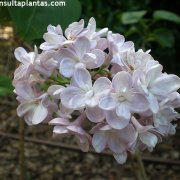Care of the shrub Syringa vulgaris or Lilac |
|
The genus Syringa, family Oleaceae, includes 30 species of shrubs and trees native to Europe, China, Turkey and Persia. Some species are: Syringa vulgaris, Syringa emodi, Syringa sweginzowii, Syringa laciniata, Syringa persica, Syringa villosa, Syringa reflexa. Common names: Common lilac, Lilac, English Lilac, French Lilac. This species is native to the Balkan Peninsula, Europe. They are shrubs or small deciduous trees that reach 7 meters (23 feet) in height. They have dark or intense green leaves, of opposite arrangement and a heart-shaped-acuminate shape. The flowers meet in conical panicles, they are small, tubular, perfumed and white, purple or lilac. They bloom in spring. Common lilac is used as isolated specimens and to form hedges. It's also grown to extract oil from flowers, and the leaves contain substances that fight malaria; From the bark and the fruits, remedies for fever are prepared. Syringa vulgaris prefers a semi-shade exposure especially in Mediterranean climates; in cooler climates it can be grown in full sun. It resists frost well. English Lilac grows well in normal garden soil that contains organic matter. Common lilac is a plant that does not require much care except watering, which we will do 2 or 3 times a week ensuring that the soil is always moist and fresh. It does not resist drought or waterlogging. Prune faded flowers. Fertilize every 7 days during flowering (spring) with mineral fertilizer and in autumn with compost or manure. Syringa vulgaris is sometimes attacked by caterpillars and leafminer insects. Common lilac is propagated by semi-woody cuttings in summer and by division of lateral shoots. |
Images of the shrub Syringa vulgaris or Lilac |
Find plants
Syringa vulgaris or Lilac | Care and Growing
© 2025 FavThemes




